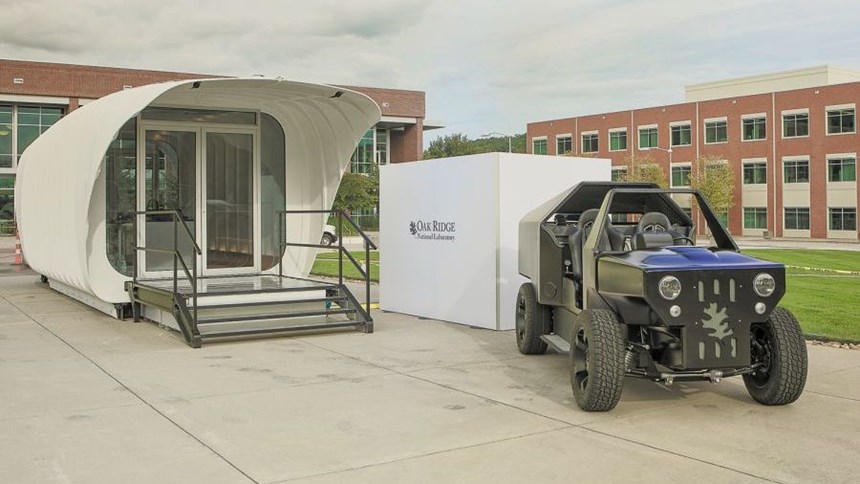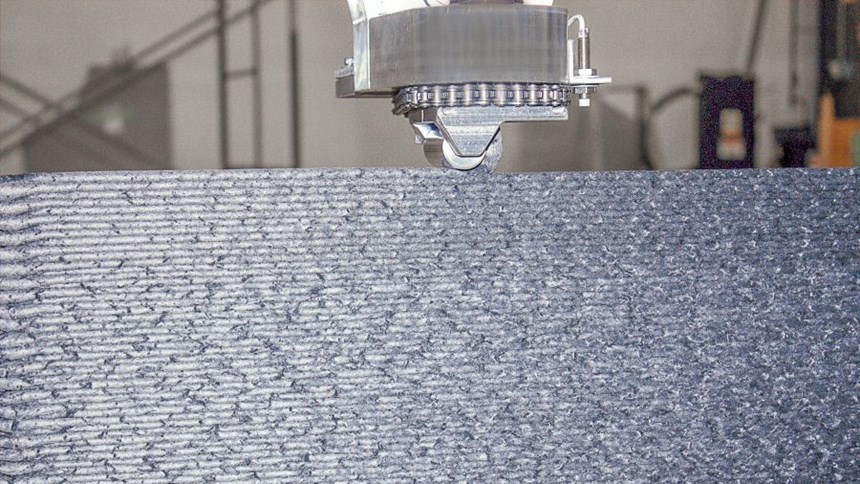AM’s Getting "Bigger" In More Than Just Cars
Large-scale additive manufacturing is disrupting the (already disruptive) 3D printing field.
Share
Read Next
This article originally appeared in Plastics Technology magazine.
When Cincinnati Inc. (CI) in Harrison, Ohio, one of that state’s oldest machine tool builders, decided to diversify its business, it probably wasn’t expected that this 100-year-plus company would jump into the fast-moving additive manufacturing field. But the Department of Energy’s Oak Ridge National Laboratory (ORNL) in Oak Ridge, Tennessee, was looking for a partner to bring to market large-scale additive manufacturing that would also lower the cost and increase the speed of the process. Matt Garbarino, marketing manager for CI, said that it quickly become apparent that CI’s laser-cutting system could be modified to make large 3D-printed parts. So CI adapted its system to include an extruder, cutting tool, pellet-feed mechanism and control software. “And BAAM was born,” Gabarino said.
Big Area Additive Manufacturing (BAAM) is a large-scale system capable of printing polymer components up to 10 times larger and at speeds 200 to 500 times faster than existing AM machines. BAAM was designed to allow 3D printing to be used for production of large parts, quickly.
CI, ORNL and Local Motors of Chandler, Arizona, made quite a splash at the IMTS 2014 show in Chicago when they created the world’s first 3D-printed car on-site at the trade show. In 2015, CI and ORNL made headlines again when their next-generation manufacturing process took on a 50-year-old icon as researchers transformed the classic Shelby Cobra sports car into a 3D-printed laboratory on wheels.
Researchers printed the Cobra at the U.S. Dept. of Energy’s Manufacturing Demonstration Facility at ORNL, using CI’s BAAM machine. The 635-kg car includes 227 kg of BAAM-printed parts, using carbon-fiber-reinforced ABS provided by SABIC Americas, Houston. “It made the rounds around the world in 2015 as a showpiece of where 3D printing can go,” Garbarino said.
Beyond Cars
But BAAM wasn’t created just to 3D print cars—it can go bigger. The machine introduces significant new manufacturing capabilities to a wide range of industries, including aerospace, appliances and robotics.
For instance, ORNL, CI and other industrial partners worked to create the Additive Manufacturing Integrated Energy (AMIE) demonstration, which seeks to become a model for energy-efficient systems that link buildings, vehicles, and the electrical grid. Rapid-prototyping and additive manufacturing processes took the AMIE project from concept to completion in less than a year. Both a house and a vehicle were printed with BAAM.
The team manufactured and connected a natural-gas-powered hybrid electric vehicle with a solar-powered building to create an integrated energy system. Power can flow in either direction between the vehicle and building through a new wireless technology. The approach allows the car to provide supplemental power to the 210-square-foot house when the sun is not shining. Carbon-fiber/ABS was used for about 80 percent of the house components and 30 percent of the car. The 38 × 12 × 13-foot building was designed by architecture firm Skidmore, Owings, and Merrill through the Univ. of Tennessee-ORNL Governor’s Chair for Energy and Urbanism.
Other applications CI has worked on include a 3D-printed replica of an F-22 Raptor drone and a 3D-printed kayak. In addition, CI will use BAAM to print a replica of an Orion spacecraft in several large pieces and assemble them on-site at the RAPID 2016 show May 16-19 in Orlando, Florida.
“It has been a phenomenon compared with other machinery—no one else is doing this at the level we are,” Garbarino said. “We have different industries contacting us because so many of them are interested in additive manufacturing and are looking to find a way to leverage it. As time goes on, the limit for BAAM will be our imagination.”
Other Large-Scale AM Developments
Strangpresse in Youngstown, Ohio, was founded in 2014 as an affiliate of Hapco Inc., which makes hot-air welding tools. The company is focused on fully controllable, lightweight, thermoplastic extruders, primarily for AM. The machine builder has a licensing agreement with ORNL regarding use of patents related to BAAM. Under the agreement, Strangpresse may make, use or sell the lab’s patented developments of materials, processes and controls that enable the manufacture of parts much larger than current standards. Strangpresse is also working with MD Plastics (Columbiana, Ohio) to develop a vertical, robot-arm mounted extrusion head that can deposit a continuous strand of material at about 100 pounds per hour. MD Plastics develops and produces plasticating components for injection molding and extrusion.
Charles George, CEO of Hapco and a principal of Strangpresse, said that the company is focused on the composites side—specifically, processing long fibers in order to strengthen the “build,” or part. “Most people can process carbon fiber at a short length, but the challenge is processing carbon fiber and maintaining the fiber length,” he said. “A lot of research is being done on the orientation of carbon fibers to try and figure how to control and understand the direction of fibers.”
In addition, Thermwood Corp. (Dale, Indiana) a maker of CNC machining systems, is working on a large-scale additive-manufacturing (LSAM) program that can perform both the “additive and subtractive” functions on the same machine. Called “near-net-shape” manufacturing, this approach uses a high-volume thermoplastic 3D printer to quickly create a part that is close to the final shape. The CNC cutting head then machines the part to the final dimensions.
Thermwood’s developmental system utilizes a 1.75-inch extruder custom engineered by American Kuhne (Ashaway, Rhode Island). Thermwood expects to outfit this initial test machine, which can print parts up to 10 × 10 × by 5 feet, with a five-axis gantry trimming system in the next few months.
Testing included initial validation of Thermwood’s MeltShape Technology for enhanced control of layer shape and improved bonding between layers. This new, patent-pending approach uses one or more shaping wheels to form and compress the plastic melt as it is being extruded, ensuring that each new layer is the proper shape and thickness and that it bonds firmly to previously applied material.
Thermwood plans to continue this development effort with the goal of offering these machines in a variety of large sizes for commercial applications, specifically targeting aerospace patterns and molds.
Related Content
8 Cool Parts From RAPID+TCT 2022: The Cool Parts Show #46
AM parts for applications from automotive to aircraft to furniture, in materials including ceramic, foam, metal and copper-coated polymer.
Read MoreMultimaterial 3D Printing Enables Solid State Batteries
By combining different 3D printing processes and materials in a single layer, Sakuu’s Kavian platform can produce batteries for electric vehicles and other applications with twice the energy density and greater safety than traditional lithium-ion solutions.
Read MoreSeurat: Speed Is How AM Competes Against Machining, Casting, Forging
“We don’t ask for DFAM first,” says CEO. A new Boston-area additive manufacturing factory will deliver high-volume metal part production at unit costs beating conventional processes.
Read MoreWhat Does Additive Manufacturing Readiness Look Like?
The promise of distributed manufacturing is alluring, but to get there AM first needs to master scale production. GKN Additive’s Michigan facility illustrates what the journey might look like.
Read MoreRead Next
4 Ways the Education and Training Challenge Is Different for Additive Manufacturing
The advance of additive manufacturing means we need more professionals educated in AM technology.
Read MoreHybrid Additive Manufacturing Machine Tools Continue to Make Gains (Includes Video)
The hybrid machine tool is an idea that continues to advance. Two important developments of recent years expand the possibilities for this platform.
Read MoreAt General Atomics, Do Unmanned Aerial Systems Reveal the Future of Aircraft Manufacturing?
The maker of the Predator and SkyGuardian remote aircraft can implement additive manufacturing more rapidly and widely than the makers of other types of planes. The role of 3D printing in current and future UAS components hints at how far AM can go to save cost and time in aircraft production and design.
Read More

























